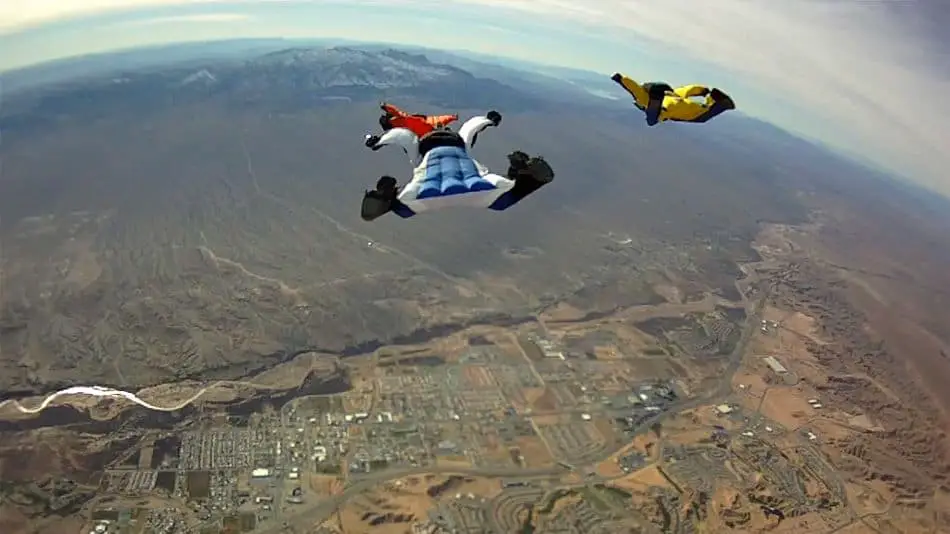
Wingsuit flying is one of the coolest things in skydiving because it allows you to “fly” through the sky. In recent years, there have been many debates about whether it was possible to gain altitude with a Wingsuit or not.
There is the possibility to go up with a Wingsuit – although the altitude gain is marginal and will only last for 1-2 seconds. To gain altitude, the wingsuit flyer must have the required skills, the right wingsuits, and jump in the appropriate weather conditions.
Although it sounds like a lot of fun, not many wingsuit flyers perform the maneuver frequently and with ease. In the following, I am going to explain the reasons behind it and clarify the myth about how to go up with a wingsuit.
How Much Can a Wingsuit Flyer Go up?
As a rule of thumb, skilled wingsuit flyers can go up by 10-15 ft (3-5 meters). As of now, there is no discipline or world record about the highest altitude ascent during wingsuit flying. To gain altitude, wingsuit flyers depend a lot on the weather conditions, the wingsuit type, and their skills.
Although it does not sound much to go up 10-15 ft, it is not that bad considering that wingsuit flyers have a low glide ratio compared to other gliders such as paragliders. Skilled wingsuit pilots have a glide ratio of 5:1 which is significantly lower than the 50:1 ratio of other gliders. Gaining 10 feet with a wingsuit is, therefore, harder than gaining 30 ft with a glider and requires more skill.
The glide ratio describes how much (horizontal) distance is covered for every lost foot/meter of altitude. For example, a glide ratio of 2:1 means that the flyer travels 2 feet for every foot of lost altitude.
How to Gain Altitude With a Wingsuit?
Gaining altitude with a wingsuit is a function of three factors: type of wingsuit, weather conditions, and skills of the pilot.
The Role Of The Wingsuit When Trying To Fly Up
One of the reasons why gliders have a significantly better glide ratio than wingsuits is that they have bigger wings and therefore a bigger surface. A big surface is crucial because it will increase the air resistance of a flyer and decrease the falling speed.
If the falling speed is lower, the wingsuit pilot needs to counteract less downward force and it becomes easier to go up. A bigger surface will also give you more upward drag when you make the upward move.
To measure the readiness of a wingsuit, you can observe the surface-weight ratio. Ideally, you want to have as much surface as possible combined with the lowest weight possible. This ratio, therefore, should be reflected in your wingsuit choice.
You will also see how crucial the surface-weight ratio is when you look at ski jumping. The top athletes are all very tall and slim (in fact they are often on a special diet to bring down their weight as much as possible).
The Role of The Weather When Trying to Go up With a Wingsuit
The second big factor is the weather. In general, you wouldn’t want to jump in stormy or very foggy weather. When it comes to going up in a wingsuit, strong winds can actually help. Nonetheless, you should try to jump in clear conditions, especially if you perform a low-altitude jump.
Winds from the front will help wingsuit flyers go up more easily. By pulling back the upper body, the wingsuit pilot increases the surface of his wings with the front wind. The wind will then give some uplift, resulting in an ascend. The stronger the front wind the higher the uplift will be.
Another strategy is to jump in conditions with upward winds. The ascending air can also help wingsuit pilots to fly up.
That being said, it is often not advisable to jump in these conditions as they are less predictable. After all, it is not worth risking safety in order to perform a cool stunt.
Piloting Skills Matter When Trying to Go up in a Wingsuit
Piloting skills matter when trying to go up, because inexperienced wingsuit pilots often miss the right moment to perform the maneuver. Experienced ones, on the other hand, know when to change their position and how to steer their wingsuit at the right angle to the wind.
In order to do so, wingsuit pilots need to be able to read the weather conditions during the jump. Wingsuit pilots are already experienced skydivers with at least 200 jumps under their belt, nonetheless, they will improve their sense of weather through wingsuit flying. When being able to read the wind, wingsuit flyers will develop a sense of the right timing to go up.
If you’re wondering whether wingsuit flying is difficult to learn and master, my latest post has all the answers. I dive into the intricacies of this adrenaline-fueled activity, exploring the surprising skills and experience required to succeed in the world of wingsuit flying.
Why Have There Been So Many Myths Around Wingsuit Ascent?
The first reason why there are so many myths around this topic is because of fake videos. You probably have already watched one, in which it looks as if the wingsuit flyer was going up significantly. However, these are usually fake.
People post these fake videos to gain fame, which they then can turn into followers and ultimately money. While I get, why they do it, I struggle with the fake aspects. In the end, it gives people a false impression of what is possible and what no.
By doing so, people’s expectations are biased and changed for the worse. If ordinary people then watch a video of an actual stunt, it might not look as impressive anymore even though the stunt is already pushing the boundaries of what is possible.
The second reason for the myths that you can go up significantly with a wingsuit is due to the videographer’s perspective or the environment around the wingsuit flyer.
If the wingsuit flyer is filmed by a videographer, the videographer might change his motion by flying more downward. If the filmed wingsuit flyer then keeps his position, it looks as if he was going up because the relative distance between them changes.
A second scenario might arise if a wingsuit flyer is flying close to the ground. You might see different rocks, trees, and hills in the video. Then the environment and the speed of the wingsuit flyer might change, resulting in the impression that the wingsuit flyer goes up.
Is It Fun To Go Up With a Wingsuit?
As a general rule, it can be a lot of fun going up in a wingsuit. Many people report choosing wingsuit flying as a hobby because it gives them a feeling of flying. Going up with a wingsuit provides the exact feeling of flying.
In addition, many wingsuit flyers and skydivers love to challenge themselves and learn new skills. As outlined earlier, flying up can only be done with a proper technique. Many skydivers use it as a way to improve their skills and afterward to feel a level of accomplishment.
It is even more fun if another skydiver records the stunt on a video. Then one can show it to their friends, colleagues, and instructors. One might also receive some fame when posting it on social media.
Wingsuit flying has gained immense popularity in recent years, attracting adrenaline junkies from around the world. While the dangers of the sport are well-known, many people are still drawn to the thrill of wingsuit flying. In this post, I explore the reasons behind this fascination and answer the question: Why do people fly wingsuits?
The fun obviously ends if one wants to perform the maneuver too much. Some skydivers might try to jump in extreme weather conditions to be able to fly up. This obviously goes too far because they then put their safety on the line.
Enjoy your free fall!
Photo Credits
Richard Schneider from Los Angeles, CC BY 2.0 https://creativecommons.org/licenses/by/2.0, via Wikimedia Commons, cropped, size changed

